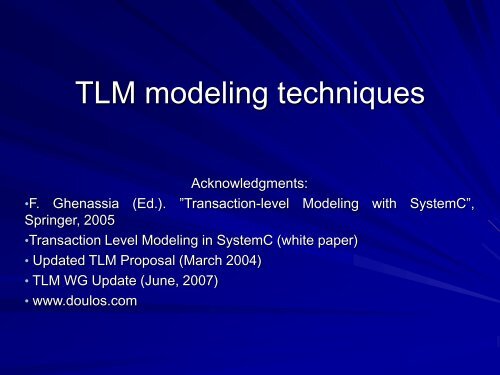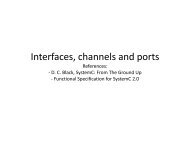TLM Modeling Techniques
TLM Modeling Techniques
TLM Modeling Techniques
Create successful ePaper yourself
Turn your PDF publications into a flip-book with our unique Google optimized e-Paper software.
<strong>TLM</strong> modeling techniques<br />
Acknowledgments:<br />
•F. Ghenassia (Ed.). ”Transaction-level <strong>Modeling</strong> with SystemC”,<br />
Springer, 2005<br />
•Transaction Level <strong>Modeling</strong> in SystemC (white paper)<br />
• Updated <strong>TLM</strong> Proposal (March 2004)<br />
• <strong>TLM</strong> WG Update (June, 2007)<br />
• www.doulos.com
Communication via sc_port
sc_export<br />
It is a new type of port introduced with SytemC 2.1<br />
Like sc_port, its declaration is defined on an interface<br />
It is different from sc_port<br />
– sc_export is used to implement the channel inside a module and<br />
still make it accessible from the outside
Communication via sc_export<br />
<strong>TLM</strong> relies both on sc_port and sc_export
2005 2006 2007<br />
2008<br />
- <strong>TLM</strong> 1.0 provides some low-level interfaces for transaction-level<br />
communication<br />
- put, get, nb_put, nb_get, transport<br />
- such interfaces are included in <strong>TLM</strong>-2.0<br />
- <strong>TLM</strong> 2.0-draft1 and <strong>TLM</strong>2.0-draft2 extend <strong>TLM</strong>1.0 by introducing<br />
- the nb_transport<br />
- a generic payload + extensions (for memory-mapped bus<br />
modeling)
Key concepts in <strong>TLM</strong><br />
<strong>TLM</strong> focuses on proposing a communication standard<br />
and is based on SystemC<br />
Particular emphasis on<br />
– Blocking vs. non blocking<br />
– Bidirectional vs. unidirectional<br />
– Interfaces. They are the real key to <strong>TLM</strong>: the goal is to define a<br />
small set of generic, reusable interfaces
Blocking vs. non blocking<br />
Contains wait(.) –<br />
OSCI Terminology process is Can be called from<br />
suspended<br />
Blocking Possibly SC_THREAD only<br />
Non Blocking No<br />
SC_METHOD or<br />
SC_THREAD
Unidirectional vs. bidirectional<br />
Unidirectional interfaces send data in only a single<br />
direction<br />
Bidirectional interfaces send data in both directions<br />
Examples:<br />
– A complete read transaction across the bus is bidirectional<br />
– Send IP packet is unidirectional<br />
Any complex protocol can be broken down into a set of<br />
unidirectional and bidirectional accesses that use the<br />
<strong>TLM</strong> API (Application Programming Interface)
Unidirectional interfaces<br />
Based on the sc_fifo interfaces as in SystemC 2.1<br />
Further split into:<br />
– Unidirectional blocking interfaces<br />
– Unidirectional non blocking interfaces<br />
A transaction from initiator to target is called put<br />
A transaction from target to initiator is called get<br />
A non consuming interface that reads the most recent<br />
valid value is peek<br />
These interfaces can be implemented in a fifo, some<br />
other channel, or directly in the target by using sc_export
Unidirectional blocking interfaces<br />
They never fail<br />
because they<br />
are blocking
- <strong>TLM</strong> 2.0 does not support either of these coding styles
Unidirectional non blocking interfaces<br />
They may fail<br />
because they are<br />
non blocking
Bidirectional blocking interface<br />
It models transactions with a tight one-to-one binding<br />
between request going in and response coming out<br />
Typically used in PV<br />
– A read can be seen as an address going in and the read data<br />
coming out<br />
It can be considered a merger between the blocking get<br />
and put functions
Summary for core <strong>TLM</strong> interfaces
Core <strong>TLM</strong> channels<br />
tlm_fifo<br />
– It implements all the unidirectional interfaces mentioned before<br />
– It is based on sc_fifo<br />
– a transaction put into the tlm_fifo is not available for getting until<br />
the next delta cycle (request-update / update scheme)<br />
– It can be zero or infinite sized
Core <strong>TLM</strong> channels (cont’ed)<br />
tlm_req_rsp_channel<br />
– It consists of two fifos<br />
one for the request going from initiator to target<br />
one for the response being moved from target to initiator<br />
– Direct access to these fifos is provided as follows:<br />
the put request and get response interfaces are exported to the initiator<br />
the get request and put response interfaces are exported to the target<br />
– This has been all grouped into master & slave interfaces
Core <strong>TLM</strong> channels (cont’ed)<br />
tlm_transport_channel<br />
– used to model situations in which each request is tightly bound to<br />
one response<br />
– Because of this tight one to one binding, the request and<br />
response fifos must be of size one<br />
– It directly exports the same interfaces exported by<br />
tlm_req_rsp_channel
<strong>Modeling</strong> API<br />
API (Application Programming Interface)<br />
– It is a set of procedures available to the programmer and able to<br />
provide an abstraction that hides the underlying hardware<br />
When modeling API, 3 levels are distinguished<br />
– Core <strong>TLM</strong> interface layer<br />
It is the layer upon which <strong>TLM</strong> protocols and IPs can be developed<br />
These are the interfaces provided by the <strong>TLM</strong> Library<br />
– Protocol layer<br />
– IP layer
<strong>TLM</strong> layered approach for API
API: <strong>TLM</strong> Protocol layer - overview<br />
Various communication protocols can be defined on the<br />
top of the <strong>TLM</strong> interface layer<br />
These protocols rely fully on the core <strong>TLM</strong> interface to<br />
transfer a transaction between two different points<br />
For each <strong>TLM</strong> protocol, a set of methods is defined<br />
(convenience functions)
API: defining a <strong>TLM</strong> protocol<br />
To create a new protocol, the following is needed:<br />
1. A suitable <strong>TLM</strong> interface must be chosen<br />
2. The protocol between initiator and target is defined for:<br />
Exchanged information<br />
Protocol interface
Choosing the right interface for a <strong>TLM</strong> protocol<br />
It depends on the protocol to be implemented<br />
In a design, more than one protocol can be implemented<br />
Each protocol can either be uni- or bidirectional<br />
– Bidirectional: it uses blocking bidirectional interface<br />
Request is a parameter of the function call<br />
Response is the return value of the function call<br />
– Unidirectional: it uses either blocking or non blocking<br />
unidirectional interface<br />
Examples:<br />
Initiators send requests and get responses<br />
Targets get requests and send responses<br />
– Untimed <strong>TLM</strong> protocol can be<br />
Bidirectional: if it is based on the read/write<br />
Unidirectional: if it broadcasts a transaction without waiting for any response<br />
– Timed <strong>TLM</strong> protocol is usually unidirectional, as it implements<br />
timing notions
API: IP layer<br />
<strong>TLM</strong> IPs are modeled on top of a <strong>TLM</strong> protocol layer as<br />
functional modules<br />
Communication between <strong>TLM</strong> IPs are done through the<br />
communication API defined in the protocol interface
Initiator port<br />
An initiator is a <strong>TLM</strong> module implementing one or more<br />
processes, which can generate transactions to the<br />
channel module<br />
An initiator is always modeled as a SystemC module:<br />
– It declares processes to model its behavior<br />
– It instantiates one or more ports to be bound to the<br />
communication channel<br />
A process inside an initiator starts communication by:<br />
– Employing the convenient functions of the protocol interface in<br />
the initiator port
Target modeling<br />
A target is a <strong>TLM</strong> module modeled by implementing a<br />
SystemC module that takes charge of the IP behavior<br />
– Model IP behavior at the functional level without any microarchitectural<br />
details<br />
– Implement the <strong>TLM</strong> interface

















